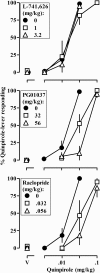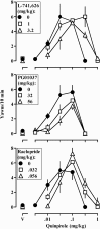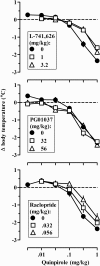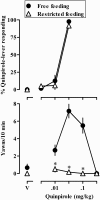Dopamine D3 receptors mediate the discriminative stimulus effects of quinpirole in free-feeding rats
- PMID: 19797621
- PMCID: PMC2802477
- DOI: 10.1124/jpet.109.158394
Dopamine D3 receptors mediate the discriminative stimulus effects of quinpirole in free-feeding rats
Abstract
The discriminative stimulus effects of dopamine (DA) D3/D2 receptor agonists are thought to be mediated by D2 receptors. To maintain responding, access to food is often restricted, which can alter neurochemical and behavioral effects of drugs acting on DA systems. This study established stimulus control with quinpirole in free-feeding rats and tested the ability of agonists to mimic and antagonists to attenuate the effects of quinpirole. The same antagonists were studied for their ability to attenuate quinpirole-induced yawning and hypothermia. DA receptor agonists apomorphine and lisuride, but not amphetamine and morphine, occasioned responding on the quinpirole lever. The discriminative stimulus effects of quinpirole were attenuated by the D3 receptor-selective antagonist N-{4-[4-(2,3-dichlorophenyl)-piperazin-1-yl]-trans-but-2-enyl}-4-pyridine-2-yl-benzamide HCl (PG01037) and the nonselective D3/D2 receptor antagonist raclopride, but not by the D2 receptor-selective antagonist 3-[4-(4-chlorophenyl)-4-hydroxypiperidin-1-yl]methyl-1H-indole (L-741,626); the potencies of PG01037 and raclopride to antagonize this effect of quinpirole paralleled their potencies to antagonize the ascending limb of the quinpirole yawning dose-response curve (thought to be mediated by D3 receptors). L-741,626 selectively antagonized the descending limb of the quinpirole yawning dose-response curve, and both L-741,626 and raclopride, but not PG01037, antagonized the hypothermic effects of quinpirole (thought to be mediated by D2 receptors). Food restriction (10 g/day/7 days) significantly decreased quinpirole-induced yawning without affecting the quinpirole discrimination. Many discrimination studies on DA receptor agonists use food-restricted rats; together with those studies, the current experiment using free-feeding rats suggests that feeding conditions affecting the behavioral effects of direct-acting DA receptor agonists might also have an impact on the effects of indirect-acting agonists such as cocaine and amphetamine.
Figures





Similar articles
-
Feeding condition and the relative contribution of different dopamine receptor subtypes to the discriminative stimulus effects of cocaine in rats.Psychopharmacology (Berl). 2014 Feb;231(3):581-91. doi: 10.1007/s00213-013-3271-x. Epub 2013 Sep 13. Psychopharmacology (Berl). 2014. PMID: 24030470 Free PMC article.
-
Dopamine agonist-induced yawning in rats: a dopamine D3 receptor-mediated behavior.J Pharmacol Exp Ther. 2005 Jul;314(1):310-9. doi: 10.1124/jpet.105.085472. Epub 2005 Apr 15. J Pharmacol Exp Ther. 2005. PMID: 15833897 Free PMC article.
-
Food restriction alters N'-propyl-4,5,6,7-tetrahydrobenzothiazole-2,6-diamine dihydrochloride (pramipexole)-induced yawning, hypothermia, and locomotor activity in rats: evidence for sensitization of dopamine D2 receptor-mediated effects.J Pharmacol Exp Ther. 2008 May;325(2):691-7. doi: 10.1124/jpet.107.133181. Epub 2008 Feb 27. J Pharmacol Exp Ther. 2008. PMID: 18305018 Free PMC article.
-
You are what you eat: influence of type and amount of food consumed on central dopamine systems and the behavioral effects of direct- and indirect-acting dopamine receptor agonists.Neuropharmacology. 2012 Jul;63(1):76-86. doi: 10.1016/j.neuropharm.2012.02.005. Epub 2012 Feb 23. Neuropharmacology. 2012. PMID: 22710441 Free PMC article. Review.
-
Current perspectives on selective dopamine D(3) receptor antagonists as pharmacotherapeutics for addictions and related disorders.Ann N Y Acad Sci. 2010 Feb;1187:4-34. doi: 10.1111/j.1749-6632.2009.05149.x. Ann N Y Acad Sci. 2010. PMID: 20201845 Free PMC article. Review.
Cited by
-
Effect of Hallucinogens on Unconditioned Behavior.Curr Top Behav Neurosci. 2018;36:159-199. doi: 10.1007/7854_2016_466. Curr Top Behav Neurosci. 2018. PMID: 28224459 Free PMC article. Review.
-
Dopamine D(3) receptors contribute to methamphetamine-induced alterations in dopaminergic neuronal function: role of hyperthermia.Eur J Pharmacol. 2014 Jun 5;732:105-10. doi: 10.1016/j.ejphar.2014.03.023. Epub 2014 Mar 28. Eur J Pharmacol. 2014. PMID: 24685638 Free PMC article.
-
Haloperidol and rimonabant increase delay discounting in rats fed high-fat and standard-chow diets.Behav Pharmacol. 2014 Dec;25(8):705-16. doi: 10.1097/FBP.0000000000000058. Behav Pharmacol. 2014. PMID: 25000488 Free PMC article.
-
Feeding condition and the relative contribution of different dopamine receptor subtypes to the discriminative stimulus effects of cocaine in rats.Psychopharmacology (Berl). 2014 Feb;231(3):581-91. doi: 10.1007/s00213-013-3271-x. Epub 2013 Sep 13. Psychopharmacology (Berl). 2014. PMID: 24030470 Free PMC article.
-
Characterization of the transport, metabolism, and pharmacokinetics of the dopamine D3 receptor-selective fluorenyl- and 2-pyridylphenyl amides developed for treatment of psychostimulant abuse.J Pharmacol Exp Ther. 2010 Jun;333(3):854-64. doi: 10.1124/jpet.109.165084. Epub 2010 Mar 12. J Pharmacol Exp Ther. 2010. PMID: 20228156 Free PMC article.
References
-
- Acri JB, Carter SR, Alling K, Geter-Douglass B, Dijkstra D, Wikström H, Katz JL, Witkin JM. (1995) Assessment of cocaine-like discriminative stimulus effects of dopamine D3 receptor ligands. Eur J Pharmacol 281:R7–R9 - PubMed
-
- Appel JB, Weathersby RT, Cunningham KA, Callahan PM, Barrett RL. (1988) Stimulus properties of dopaminergic drugs: comparisons involving selective agonists and antagonists. Psychopharmacol Ser 4:44–56 - PubMed
-
- Baker LL, Hood CA, Heidema AM. (1990) Assessment of D3 versus D2 receptor modulation of the discriminative stimulus effects of (+)-7-OH-DPAT in rats. Behav Pharmacol 10:717–722 - PubMed
-
- Bristow LJ, Cook GP, Patel S, Curtis N, Mawer I, Kulagowski JJ. (1998) Discriminative stimulus properties of the putative dopamine D3 receptor agonist, (+)-PD 128907: role of presynaptic dopamine D2 autoreceptors. Neuropharmacology 37:793–802 - PubMed
Publication types
MeSH terms
Substances
Grants and funding
LinkOut - more resources
Full Text Sources

